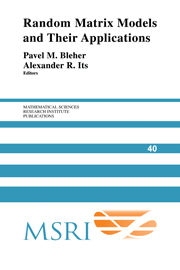Book contents
- Frontmatter
- Contents
- Preface
- Symmetrized Random Permutations
- Hankel Determinants as Fredholm Determinants
- Universality and Scaling of Zeros on Symplectic Manifolds
- z-Measures on Partitions, Robinson-Schensted-Knuth Correspondence, and β = 2 Random Matrix Ensembles
- Phase Transitions and Random Matrices
- Matrix Model Combinatorics: Applications to Folding and Coloring
- Interrelationships Between Orthogonal, Unitary and Symplectic Matrix Ensembles
- Dual Isomonodromic Tau Functions and Determinants of Integrable Fredholm Operators
- Functional Equations and Electrostatic Models for Orthogonal Polynomials
- Random Words, Toeplitz Determinants, and Integrable Systems I
- Random Permutations and the Discrete Bessel Kernel
- Solvable Matrix Models
- The τ-Function for Analytic Curves
- Integration over Angular Variables for Two Coupled Matrices
- Integrable Lattices: Random Matrices and Random Permutations
- SL(2) and z-Measures
- Some Matrix Integrals Related to Knots and Links
Integrable Lattices: Random Matrices and Random Permutations
Published online by Cambridge University Press: 25 June 2025
- Frontmatter
- Contents
- Preface
- Symmetrized Random Permutations
- Hankel Determinants as Fredholm Determinants
- Universality and Scaling of Zeros on Symplectic Manifolds
- z-Measures on Partitions, Robinson-Schensted-Knuth Correspondence, and β = 2 Random Matrix Ensembles
- Phase Transitions and Random Matrices
- Matrix Model Combinatorics: Applications to Folding and Coloring
- Interrelationships Between Orthogonal, Unitary and Symplectic Matrix Ensembles
- Dual Isomonodromic Tau Functions and Determinants of Integrable Fredholm Operators
- Functional Equations and Electrostatic Models for Orthogonal Polynomials
- Random Words, Toeplitz Determinants, and Integrable Systems I
- Random Permutations and the Discrete Bessel Kernel
- Solvable Matrix Models
- The τ-Function for Analytic Curves
- Integration over Angular Variables for Two Coupled Matrices
- Integrable Lattices: Random Matrices and Random Permutations
- SL(2) and z-Measures
- Some Matrix Integrals Related to Knots and Links
Summary
Introduction
The purpose of this article is to survey recent interactions between statistical questions and integrable theory. Two types of questions will be tackled here:
(i) Consider a random ensemble of matrices, with certain symmetry conditions to guarantee the reality of the spectrum and subjected to a given statistics. What is the probability that all its eigenvalues belong to a given subset E? What happens, when the size of the matrices gets very large? The probabilities here are functions of the boundary points Ci of E.
(ii) What is the statistics of the length of the largest increasing sequence in a random permutation, assuming each permutation is equally probable? Here, one considers generating functions (over the size of the permutations) for the probability distributions, depending on the variable x.
The main emphasis of this article is to show that integrable theory serves as a useful tool for finding equations satisfied by these functions of x, and conversely the probabilities point the way to new integrable systems.
These questions are all related to integrals over spaces of matrices. Such spaces can be classical Lie groups or algebras, symmetric spaces or their tangent spaces. In infinite-dimensional situations, the “ ∞ -fold” integrals get replaced by Fredholm determinants.
During the last decade, astonishing discoveries have been made in a variety of directions. A first striking feature is that these probabilities are all related to Painleve equations or interesting generalizations. In this way, new and unusual distributions have entered the statistical world.
Information
- Type
- Chapter
- Information
- Random Matrix Models and their Applications , pp. 321 - 406Publisher: Cambridge University PressPrint publication year: 2001
Accessibility standard: Unknown
Why this information is here
This section outlines the accessibility features of this content - including support for screen readers, full keyboard navigation and high-contrast display options. This may not be relevant for you.Accessibility Information
- 3
- Cited by
